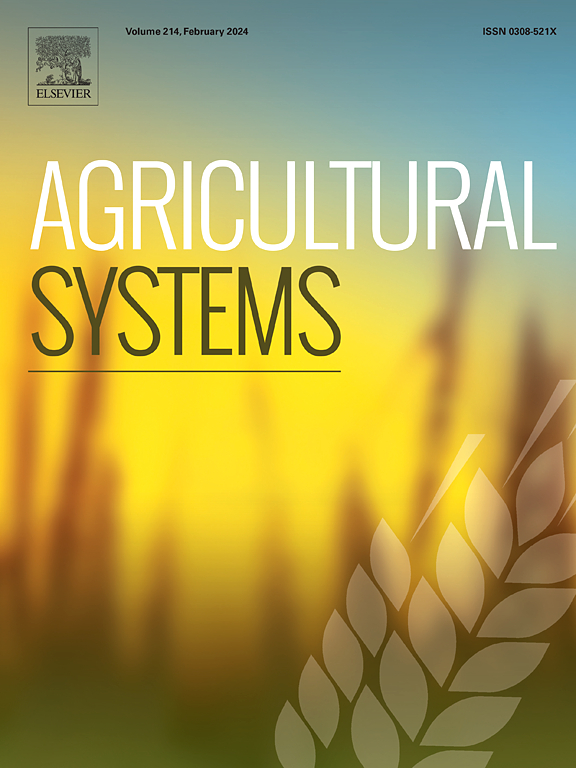Farmers' pest management strategies in oil palm production in Lake Victoria Islands, Uganda
IF 6.1
1区 农林科学
Q1 AGRICULTURE, MULTIDISCIPLINARY
引用次数: 0
Abstract
CONTEXT
Oil palm is grown widely in Lake Victoria islands of Uganda and contributes to farmers livelihoods. Nevertheless, African oil palm weevil APW,Rhynchophorus phoenicis (Coleoptera: Curculionidae) is a key insect pest of oil palm in tropical Africa, causing serious damage to oil palm plantations. Overdependence on synthetic insecticides to control APW is not effective and unsustainable. A better understanding of effective integrated pest management (IPM) strategies for APW in Uganda is required to reduce use of synthetic insecticides and enhance sustainable production of oil palm. Current farmer APW management practices might be affected by farm characteristics and production practices. This can result in ineffective control options of APW.
OBJECTIVE
Evaluated farm characteristics and production practices as well as APW infestation, assessed pest management methods for APW control and examined effectiveness of chemical and non-chemical control practices on APW infestation across four oil palm production blocks.
METHODS
We used semi-structured guides with eight focus farmer group discussions, fourteen qualitative in–depth interviews with oil palm experts and interviewed 200 oil palm smallholder farmers across four oil palm production blocks.
RESULTS AND CONCLUSIONS
Certain farm characteristics and production practices had higher APW infestation compared to others. Chemical and non – chemical practices were used by oil palm smallholder farmers to manage APW, though farmers didn't know period of infestation, active ingredients and some couldn't tell pesticides used. There was significant difference in effectiveness when using non- chemical practices to manage APW. There is need to train farmers on IPM practices in oil palm. Further research should establish successful IPM approaches for APW to reduce pesticide use and enhance oil palm production.
SIGNIFICANCE
This study provides crucial insights into sustainable pest management practices, offering a framework for IPM implementation in smallholder oil palm farming systems in tropical Africa.

乌干达维多利亚湖群岛油棕榈生产中农民的虫害防治策略
棕榈在乌干达维多利亚湖群岛广泛种植,为农民的生计做出了贡献。然而,非洲油棕象鼻虫APW,Rhynchophorus phoenicis(鞘翅目:curculionidis科)是热带非洲油棕的主要害虫,对油棕种植园造成严重危害。过度依赖合成杀虫剂控制APW是无效的,也是不可持续的。为了减少合成杀虫剂的使用和提高油棕的可持续生产,乌干达需要更好地了解有效的综合虫害管理(IPM)战略。目前农民的APW管理做法可能受到农场特征和生产实践的影响。这可能导致APW控制选项无效。目的评估四个油棕产区的农场特征和生产实践以及APW的侵害,评估控制APW的有害生物管理方法,并检查化学和非化学控制措施对APW侵害的有效性。方法采用半结构化指南和8个重点农民小组讨论,对油棕专家进行了14次定性深入访谈,并对4个油棕生产区块的200名油棕小农进行了访谈。结果与结论特定的农场特征和生产方式对APW的侵害程度较高。油棕小农采用化学和非化学方法管理APW,但农民不知道侵染期、有效成分,有的甚至不知道使用的农药。采用非化学方法管理APW的效果有显著性差异。有必要就油棕的IPM做法对农民进行培训。进一步的研究应该为APW建立成功的IPM方法,以减少农药的使用和提高油棕的产量。本研究为可持续有害生物管理实践提供了重要见解,为热带非洲小农油棕种植系统实施IPM提供了框架。
本文章由计算机程序翻译,如有差异,请以英文原文为准。
求助全文
约1分钟内获得全文
求助全文
来源期刊

Agricultural Systems
农林科学-农业综合
CiteScore
13.30
自引率
7.60%
发文量
174
审稿时长
30 days
期刊介绍:
Agricultural Systems is an international journal that deals with interactions - among the components of agricultural systems, among hierarchical levels of agricultural systems, between agricultural and other land use systems, and between agricultural systems and their natural, social and economic environments.
The scope includes the development and application of systems analysis methodologies in the following areas:
Systems approaches in the sustainable intensification of agriculture; pathways for sustainable intensification; crop-livestock integration; farm-level resource allocation; quantification of benefits and trade-offs at farm to landscape levels; integrative, participatory and dynamic modelling approaches for qualitative and quantitative assessments of agricultural systems and decision making;
The interactions between agricultural and non-agricultural landscapes; the multiple services of agricultural systems; food security and the environment;
Global change and adaptation science; transformational adaptations as driven by changes in climate, policy, values and attitudes influencing the design of farming systems;
Development and application of farming systems design tools and methods for impact, scenario and case study analysis; managing the complexities of dynamic agricultural systems; innovation systems and multi stakeholder arrangements that support or promote change and (or) inform policy decisions.
 求助内容:
求助内容: 应助结果提醒方式:
应助结果提醒方式:


